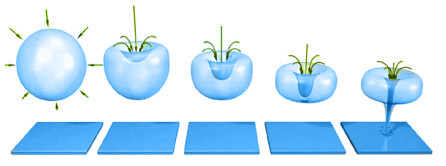Conventional Methods
Micro-nanobubble and Nanobubble generators utilize pressurized dissolution, electrolysis or by swirling fluids in a mixing chamber and then feeding the fluids through a single shear point, injector, or venturi to produce air bubbles having a mean particle size of >200 nm. The majority of these systems require an external air supply and more importantly they do little to enhance the electrochemical properties of water.The Bauer Method
The Bauer Nanobubbles Generator is a proprietary, highly engineered device that utilizes a sophisticated pattern of cavitation chambers and shear planes to initiate a controlled endothermic reaction which produces a high concentration of paramagnetic oxygen nanobubbles with a mean particle size between 50 -100 nm, while at the same time altering the chemical equilibrium of ionic species in water.
The Bauer processor is a series of partial plates housed in a pipe that is installed inline to a water system. The plates are placed in such a way that it forces the flowing water to expand and contract under shear stress many times while passing through.
The expansion and contraction in the Bauer processor creates cavitation, which is the formation of gas or vapour within a liquid due to rapid pressure changes. The Bauer processor is designed in a way that the voids are small enough to form nanobubbles, and shift the zeta potential of the particles in the water toward zero.


